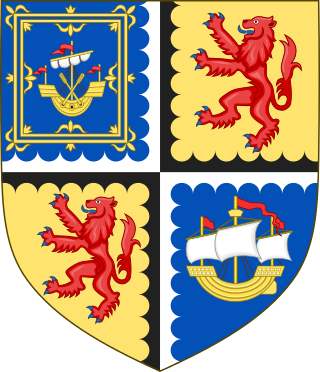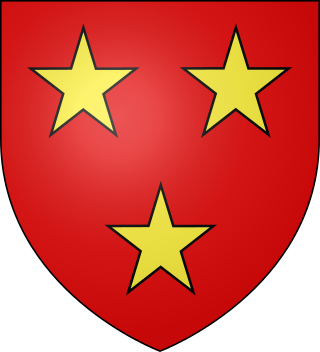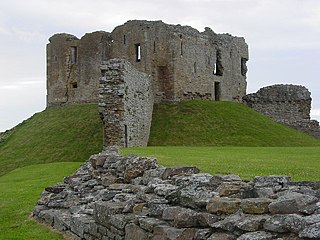William Sutherland, 7th of Duffus (died 1543) was a Scottish member of the nobility and a cadet of the Clan Sutherland.
William Sutherland, 7th of Duffus (died 1543) was a Scottish member of the nobility and a cadet of the Clan Sutherland.
He was the son of William Sutherland, 6th of Duffus who had been killed in 1530, [1] in Thurso by the Clan Gunn who according to Sir Robert Gordon, 1st Baronet had been instigated to do so by Andrew Stewart who was the Bishop of Caithness. [2]
William Sutherland, 7th of Duffus made strenuous effort's to avenge his father's death and he refused various offers of compensation that were made to him. He summoned the Bishop of Caithness who had killed his father to appear before him in Edinburgh but the Bishop ignored this. He then seized one of the Bishop's servants and as a result he and his uncle, the Dean of Caithness, were brought before the Privy Council of Scotland. They were imprisoned and forced to come to terms with the Bishop without compensation before they were set free. [3]
In around 1534, Sutherland of Duffus granted a discharge to John Murray of Cambusavie for the balance of 500 merks due to his father. On 25 September 1335 he was declared to be his farther's heir in Torboll and other lands. He granted on mortgage the lands of Kinstearie and Brichtmony to John Campbell of Calder in February 1540. In 1542, William Sutherland of Duffus was declared by a lawful jury to be the lawful heir of his father in all of the lands and rents which his father had died infeft within Inverness-shire. [3]
Also in 1542, William Sutherland of Duffus and Donald Mackay, 11th of Strathnaver submitted to the arbitration of James Stewart, Earl of Moray their claims to certain lands which had caused much blood-shed but in the end was decided in favour of Mackay which ended the feud. [3]
William Sutherland of Duffus died before the end of 1543. He married Elizabeth Stewart, who survived him and re-married to James Murray of Culbardie. William Sutherland's and Elizabeth Stewart's children were:

Clan Sutherland also known as House of Sutherland is a Highland Scottish clan whose traditional territory is the shire of Sutherland in the far north of Scotland. The chief of the clan was also the powerful Earl of Sutherland, however in the early 16th century this title passed through marriage to a younger son of the chief of Clan Gordon. The current chief is Alistair Sutherland who holds the title Earl of Sutherland.

The Battle of Tannach was a Scottish clan battle fought about 3 miles (4.8 km) southwest of Wick, in the far north of Scotland. It was fought between men of the Clan Keith and Clan Mackay from Strathnaver against men of the Clan Gunn and possibly their allies the Clan Oliphant and Clan Sutherland from Caithness. The date is uncertain, it was probably in 1464 but may have been in 1438.

The Battle of Alltan-Beath, also known as the Battle of Ailtan-Beath, was a Scottish clan battle said to have taken place in 1542 in the village of Knockarthur, in Sutherland, in the Scottish Highlands. It was fought between men of the Clan Mackay and men of the Clan Sutherland whose chiefs were the Gordon, Earls of Sutherland.

John Sinclair was a Scottish nobleman, 3rd Earl of Caithness and chief of the Clan Sinclair, a Scottish clan of the Scottish Highlands.

Robert Sutherland, was the 6th Earl of Sutherland and chief of the Clan Sutherland, a Scottish clan of the Scottish Highlands.

John Sutherland, was the 7th Earl of Sutherland and chief of the Clan Sutherland, a Scottish clan of the Scottish Highlands.
John Gordon, 11th Earl of Sutherland (1525–1567) was a Scottish magnate. John Gordon supported the chief of his family, his cousin the Earl of Huntly against the Earl of Moray. After Huntly's defeat at Corrichie, he went into exile, and shortly after his return to Scotland he was murdered by a kinswoman.
The Murrays of Aberscross were a minor noble Scottish family who were seated at Aberscross Castle, in the county of Sutherland, Scotland. The Murrays in Sutherland are recorded specifically as a clan in two Acts of the Scottish Parliament of the 16th century.
Iye Du Mackay, 12th of Strathnaver, was the chief of the Clan Mackay, a Highland Scottish clan, from 1550 to 1572.
John Mackay, 11th of Strathnaver, was the eleventh chief of the ancient Clan Mackay, a Scottish clan of the Scottish Highlands.
Donald Mackay, 11th of Strathnaver, was the eleventh chief of the ancient Clan Mackay, a Scottish clan of the Scottish Highlands.

The Battle of Torran-Roy was a Scottish clan battle that took place in the year 1570 in the county of Sutherland, Scotland. It was fought between the forces of Alexander Gordon, 12th Earl of Sutherland and the forces of George Sinclair, 4th Earl of Caithness. The Earl of Sutherland's force consisted primarily of the Murrays of Aberscross who despite their name were not part of the Clan Murray in Atholl, but who were a sept of the Clan Sutherland, and who as the principal vassals of the Earl of Sutherland, were charged with the defense of the shire. The Earl of Caithness's forces consisted primarily of followers of Alexander Sutherland, 8th of Duffus who was a descendant of the old Sutherland Earls of Sutherland who had been ousted and replaced by the Gordons as earls in the early 16th-century.

George Sinclair was a Scottish nobleman, the 4th Earl of Caithness and chief of the Clan Sinclair, a Scottish clan of the Scottish Highlands.

George Sinclair was a Scottish nobleman, the 5th Earl of Caithness and chief of the Clan Sinclair, a Scottish clan based in northern Scotland.

William de Moravia was a Scottish nobleman, Earl of Sutherland and chief of the Clan Sutherland, a Scottish clan of the Scottish Highlands.

Elizabeth Sutherland, was the 10th Countess of Sutherland having succeeded to the Earldom of Sutherland after her brother John Sutherland, 9th Earl of Sutherland died in 1514.
Alexander Gordon, 12th Earl of Sutherland was a Scottish landowner.

William Sutherland, 6th of Duffus was a member of the Scottish nobility and a cadet of the Clan Sutherland.

Alexander Sutherland, 8th of Duffus was a member of the Scottish nobility and a cadet of the Clan Sutherland.

William Sutherland, 9th of Duffus was a member of the Scottish nobility and a cadet of the Clan Sutherland.
{{cite book}}: CS1 maint: multiple names: authors list (link) CS1 maint: numeric names: authors list (link)Quoting from Gordon, Sir Robert. A Genealogical history of the Earldom of Sutherland
{{cite book}}: CS1 maint: location (link)